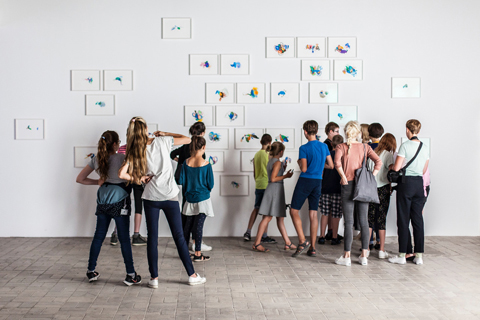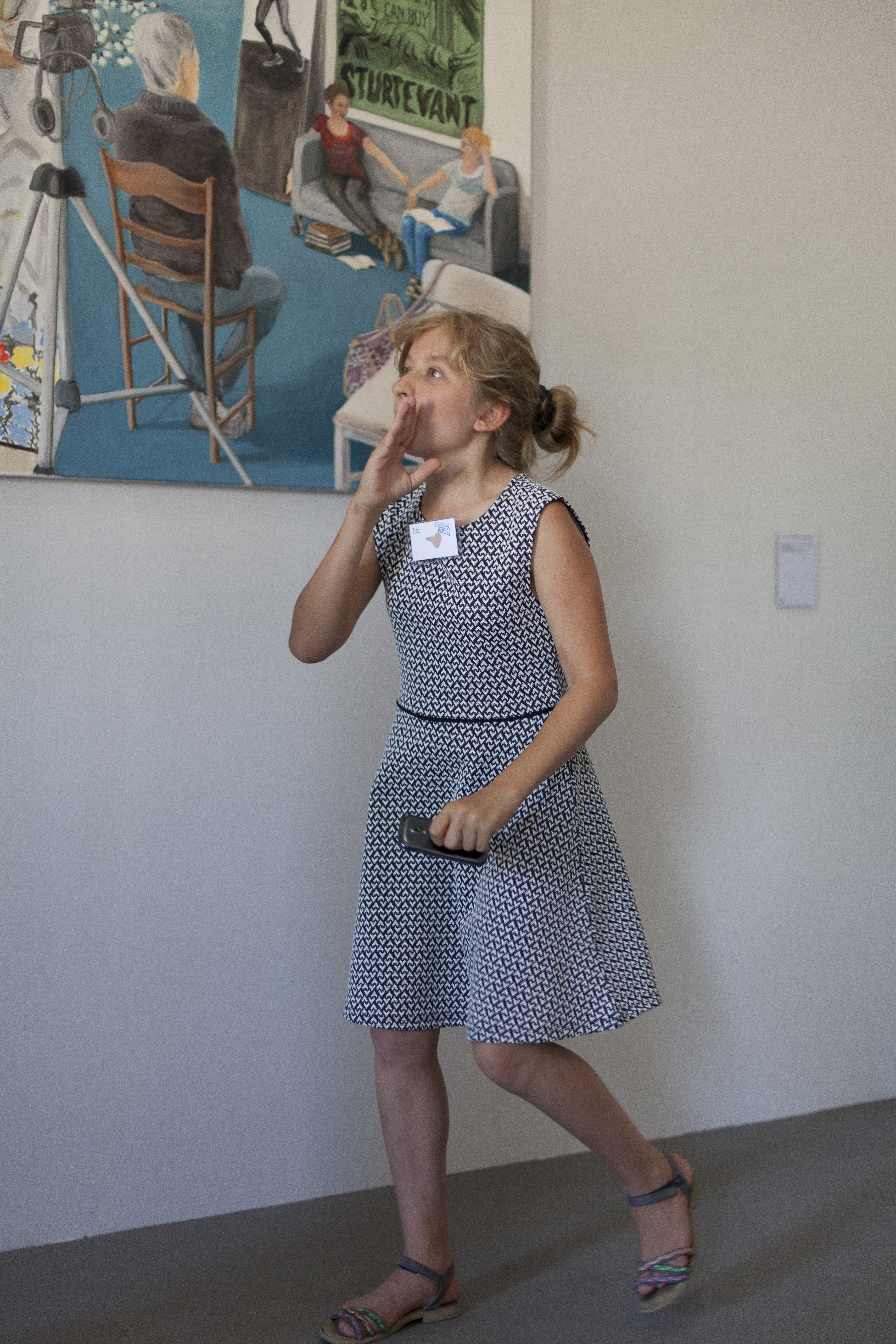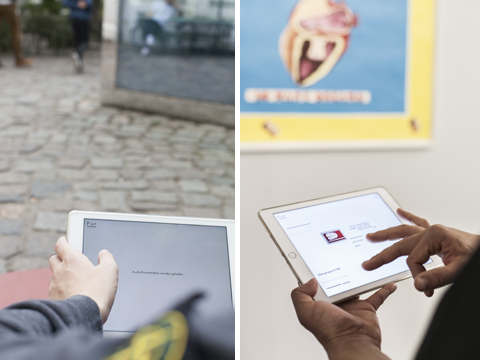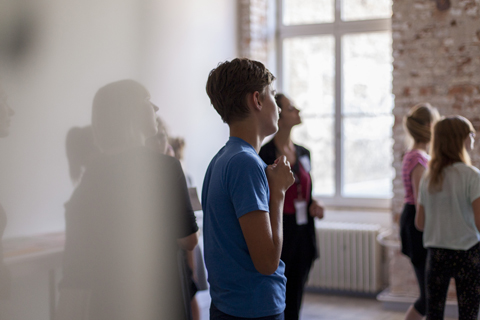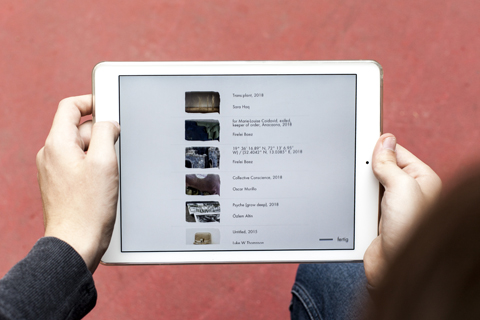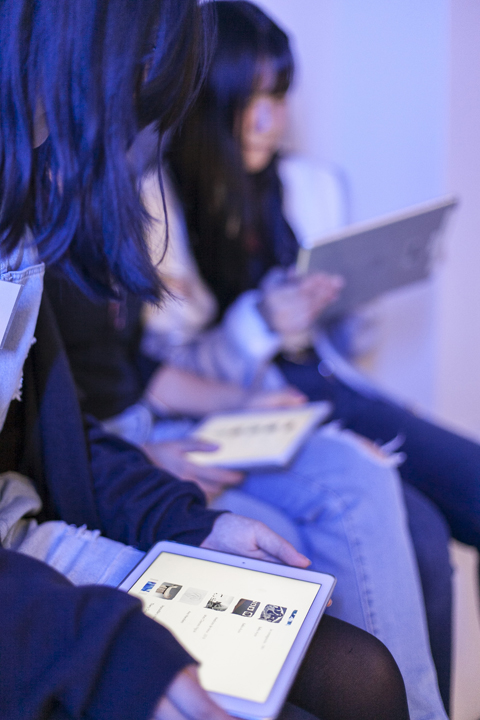APP SCOUTS
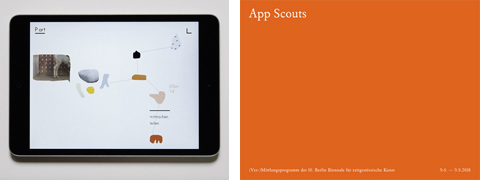
left: User interface App P art @ Cara Celine Schlenzig. The publication, published by NAIMA Editions, is in German. Click Image above to listen and read online – or grab your copy at the KW Institute for Contemporary Art ticket desk – or download here: Dowload epub 317 MB
Why another audio guide in an exhibition?
The App Scouts project is about more than just an audio guide. The genesis of this project has a long history. It began in 2016 when designer Cara Schlenzig wrote her bachelor’s degree at the art academy weißensee based on her experiences with art education projects in my seminar. The theme she chose was an app by and for young people in a museum. When I was given the opportunity to develop a concept for the education program for the 10th Berlin Biennale, I invited Cara Schlenzig to test her concept in this context. With the Carl-von-Linné School we had a partner, who enriched the project with the perspective of a special school profile for children and young people with and without special needs. This was made possible by the expertise and support of the cultural agent Maja-Lena Pastor.
Within the App Scouts project, young people explored the works of the 10th Berlin Biennale and, for example, dealt with their own history lessons at school. They discovered that there was never any mentioning of the Haitian Revolution during history lessons. In 1791, the Haitian Revolution – the uprising of enslaved people in the Santo Domingo region colonized by France – initiated the founding of the state of Haiti in 1803. It was the first independent state in Latin America and the first to be formed and governed by formerly enslaved people.
Their comments to the work 19° 36′ 16.89″ N, 72° 13′ 6.95″ W) / (52.4042° N, 13.0385° E (2018) by Firelei Báez was published on display at the exhibition for further visitors to listen to and comment on. It passed along this knowledge and made us aware of not-knowing this. This referred to the reality of school teaching. Here only a certain selection of historical contexts was discussed. Some strands were not taught at all, including the Haitian Revolution and the transatlantic slave trade. Supplements to this work by other visitors created precisely this expanded background knowledge. Thus, this project made it possible to experience on the one hand the structural “blindness” in the German educational system – and on the other hand this “blindness” as a theme in the exhibition context, also called “silencing”.
What’s the next step?
“If we turned the world upside down, so we were in the sky, it would be flawless,” a young voice comments on the work of Agnieszka Brzeżańska. At the 10th Berlin Biennale she showed ten collages from a series entitled Kobayashi Maru from 2014. The collages consist of elements on background layer, that are only visible on their outer edges. Mass animal husbandry, war, or environmental catastrophes can be detected after an intense look. On a layer above are decorative geometric shapes made of colorful or gold-colored material. During the group tours that I accompanied, I experienced that these collages first of all have been an enigma for many of the visitors – especially with regard to their titles. The perceptions of the young people, on the other hand, formed a substantial approach to their understanding. They were familiar with the title Kobayashi Maru from the series Star Trek. They described the various pictorial levels of the collages. The young people then drew up a balance sheet that reflected their realistic view of environmental pollution and power politics. And yet their descriptions did not remain with these threatening scenarios, but surprised with new perspectives linked to them, which contained utopian and irrational elements. This gave space to a range of contradictions and breaks that can go hand in hand with aesthetic experience.
I wish for the future that projects of contemporary art open up and provide more resources to enable processes like this. The potential for change can only unfold if it can be activated beyond the operating system of art.
APP SCOUTS
Students of 6th, 9th and 10th year of Carl-von-
Linné-School and Students of Johann-Gottfried-Herder-Gymnasiums
Hosted by
Alexia Manzano, Artist; Cara Celine Schlenzig, Artist
Carola Seiboth, Teacher; Carolin Pflüger, Art Educator
Gunnar Matz, IT; Holger Friese, IT and artist
Laureline van den Heuvel, Art Educator
Maja-Lena Pastor, Cultural Agent
Mona Jas, Project Director
Victoria Tomaschko, Photographer
THANKS to
Carolin Knüpper
Gabriele Horn
Jeanette Gogoll
Kati Guhle
Khadidiatou Rachel Bangoura
Konrad Muchow
Natasha A. Kelly
Rebeka Jazbec
Tobias Oettel
Tullia Tarsia in Curia
Udo Klink
Yvette Mutumba
App Scouts – funded by Aktion Mensch – was realized as part of the Mediation program of the 10th Berlin Biennale for Contemporary Art (9.6.-9.9.2018), curated by Gabi Ngcobo with Nomaduma Rosa Masilela, Serubiri Moses, Yvette Mutumba, Thiago de Paula Souza.
